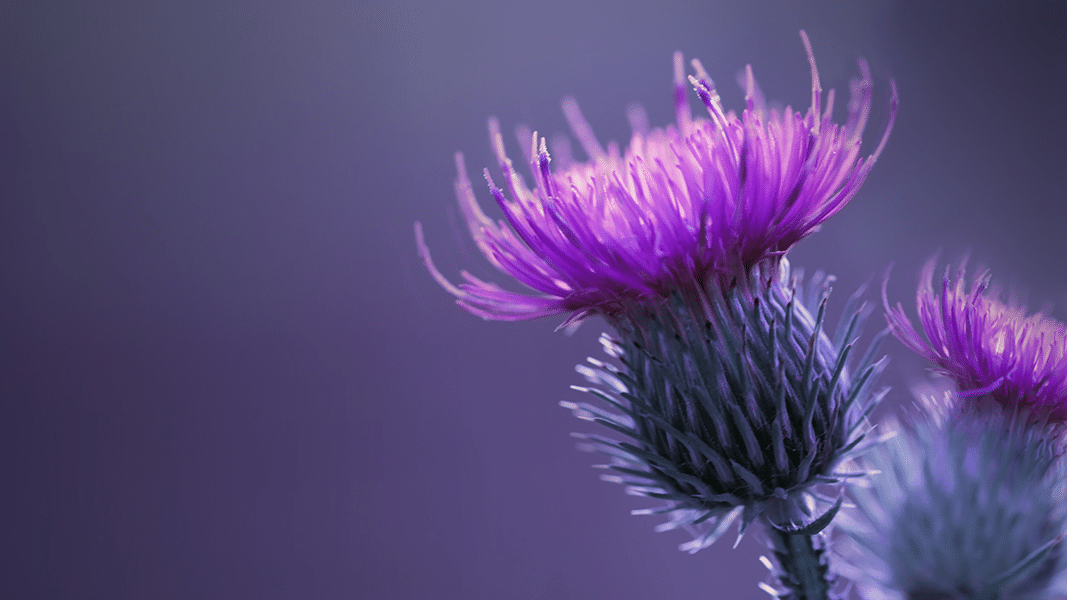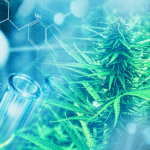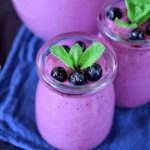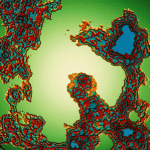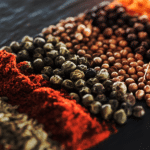What do Cannabis and Milk Thistle (Silybum marianum) have in common? Both of these versatile “weeds” have a rich history of medicinal use going back thousands of years. And both convey significant therapeutic benefits that are mediated by the endocannabinoid system.
Indigenous to the Mediterranean region but today found throughout the world, the prickly Milk Thistle is well known among herbalists as a liver tonic and a promoter of kidney and gall bladder health. Considered an invasive plant species in some areas, Milk Thistle has been used by folk healers to treat a wide range of ailments.
Dioscorides, the Greek botanist-physician, in his Materia Medica identified the plant as a remedy for snakebite. Fast forward two millennia: In 2010, Iranian scientists reported that cortisol-lowering Milk Thistle shows promise as a therapy for obsessive-compulsive disorder.
A member of the daisy family, Milk Thistle is also given to under-lactating moms to increase breast milk production. When the white-veined leaves of Milk Thistle are crushed, they exude a milky sap; hence the plant’s name. According to legend, the unctuous white sap is the Virgin Mother’s milk. Today Milk Thistle is one of the top-selling herbs available for purchase in U.S. retail markets.
The main active component of Milk Thistle is silymarin, a well-tolerated, polyphenolic flavonoid complex that lowers insulin resistance and neutralizes health-damaging free radicals. A strong antioxidant, silymarin is also present in artichokes, cilantro and coriander, but Milk Thistle extract is the richest known source of this feisty phytopharmaceutical. Silymarin actually contains three anti-inflammatory components, including silibinin, which inhibits the growth of many types of cancer cells in preclinical research.
Animal studies indicate that silymarin exerts anti-carcinogenic and anti-inflammatory effects on the skin. Topical application of silymarin may provide relief from skin disorders, such as psoriasis, which are indicative of an overtaxed liver. Silymarin can reduce liver toxicity caused by Big Pharma drugs that dermatologists prescribe to treat skin conditions.
Chronic liver disease is a major public health problem throughout the world. An estimated 200 million people, including 3.2 million in the United States, are infected with the Hepatitis C virus, the leading cause of liver failure after cirrhosis. Twenty-five thousand Americans die each year from liver cirrhosis primarily due to alcohol abuse, prescription meds (acetaminophen, for example), and other toxic chemical exposures.
Numerous clinical studies have demonstrated the hepatoprotective properties of Milk Thistle and its positive effects for patients with liver disease. Researchers continue to discover various ways that Milk Thistle is able to improve liver function and mitigate toxic overload. Silymarin stimulates the synthesis of liver-protective bile salts and it alters hepatic cell membrane permeability to prevent toxins from infiltrating and damaging liver cells. Silymarin also increases the body’s production of glutathione, a super-antioxidant that is crucial for liver detoxification.1
In 2015, a team of Egyptian scientists shed new light on silymarin’s mechanism of action in a study on liver fibrosis in rats. The scientists concluded that silymarin conveys anti-fibrogenic effects by modulating cannabinoid receptor activity in the liver. Both types of cannabinoid receptors, CB1 and CB2, are expressed in the liver, where they mediate opposing functions. Activating CB1 has a pro-fibrogenic effect; activating CB2 has the opposite effect, reducing fibrosis. Silymarin blocks CB1 while turning on CB2—a perfect combination for treating hepatic fibrosis and chronic liver disease. The Egyptian study concludes that silymarin “strongly upregulates CB2 expression and downregulates CB1 expression. These effects may be partially responsible for the strong hepatoprotective effect of silymarin.”
Tetrahydrocannabivarin (THCV), an intriguing compound unique to the cannabis plant, interacts with the cannabinoid receptors in a similar way, blocking CB1 while boosting CB2. THCV-rich cannabis would likely benefit people with liver disease by working through some of the same molecular channels as Milk Thistle. Pharmaceutical researchers, meanwhile, are seeking to develop synthetic, receptor-selective drugs that differentially engage both CB1 and CB2, much like THCV and silymarin.
Liver-Friendly Health Tips
For chronic conditions, Milk Thistle must be taken over an extended period for efficacy, perhaps as long as two years. Several other herbs support liver health, such as yellow dock, chicory, nettle, and all parts of dandelion (roots, leaves, stalks & flowers). Other liver-friendly health tips:
- Restrict alcohol consumption, avoid Tylenol and acetaminophen.
- If possible, buy food products in glass, rather than plastic containers to limit your exposure to lipophilic industrial toxins (parabens, phthalates, flame-retardants, BPA and BPS, etc.), which wreak havoc on the liver and the endocannabinoid system.
- Increase consumption of fermented foods, dark leafy greens and cruciferous vegetables. Other recommended foods include artichokes, garlic, onions, beats, avocados, berries, sprouts, and organic eggs.
- N-Acetyl L-Cysteine, a potent antioxidant, is an excellent supplement for liver conditions.
Sarah Russo is a contributor to Project CBD, a self-taught lover of herbs, and an avid globetrotter. She is currently based in Granada, Spain. © Copyright, Project CBD. May not be reprinted without permission.
Footnotes
- It appears that silymarin is less able to repair liver injury and generate new liver cells during the late stages of cirrhosis and hepatitis. Whereas silymarin can reduce liver inflammation, chronic Hepatitis C viral infection may weaken the liver to such an extent that it can’t process silymarin’s constituents for liver repair and regeneration. The extraction of silymarin from Milk Thistle is another factor that may account for inconsistent clinical findings. Silymarin does not include several key components, such as dihydroquercetin, that are present in whole plant Milk Thistle; without these components, silymarin’s efficacy as a therapeutic agent may be compromised.
Sources
- Crocenzi FA, Roma MG. Silymarin as a new hepatoprotective agent in experimental cholestasis: new possibilities for an ancient medication. Curr Med Chem. 2006;13(9):1055-74. PubMed PMID: 16611084.
- El Swefy S, Hasan RA, Ibrahim A, Mahmoud MF. Curcumin and hemopressin treatment attenuates cholestasis-induced liver fibrosis in rats: role of CB1 receptors. Naunyn Schmiedebergs Arch Pharmacol. 2016 Jan;389(1):103-16. PubMed PMID: 26475620.
- Guo Y, Wang S, Wang Y, Zhu T. Silymarin improved diet-induced liver damage and insulin resistance by decreasing inflammation in mice. Pharm Biol. 2016 Dec;54(12):2995-3000. PubMed PMID: 27387273.
- Kalantari H, Shahshahan Z, Hejazi SM, Ghafghazi T, Sebghatolahi V. Effects of silybum marianum on patients with chronic hepatitis C. J Res Med Sci. 2011 Mar;16(3):287-90. PubMed PMID: 22091246; PubMed Central PMCID: PMC3214335.
- Kang JS, Yoon WK, Han MH, Lee H, Lee CW, et al. Inhibition of atopic dermatitis by topical application of silymarin in NC/Nga mice. Int Immunopharmacol. 2008 Oct;8(10):1475-80. PubMed PMID: 18593606.
- Li F, Ma Z, Guan Z, Chen Y, Wu K, et al. Autophagy induction by silibinin positively contributes to its anti-metastatic capacity via AMPK/mTOR pathway in renal cell carcinoma. Int J Mol Sci. 2015 Apr 15;16(4):8415-29. PubMed PMID: 25884331; PubMed Central PMCID: PMC4425089.
- Lucena MI, Andrade RJ, de la Cruz JP, Rodriguez-Mendizabal M, Blanco E, et al. Effects of silymarin MZ-80 on oxidative stress in patients with alcoholic cirrhosis Results of a randomized, double-blind, placebo-controlled clinical study. Int J Clin Pharmacol Ther. 2002 Jan;40(1):2-8. PubMed PMID: 11841050.
- Mahjoor AA, Dehghan A. Effect of silymarin on metabolic factors of food-restricted over conditioned Wistar rats. Pak J Biol Sci. 2008 Jul 15;11(14):1835-9. PubMed PMID: 18817226.
- Mortel M, Mehta SD. Systematic review of the efficacy of herbal galactogogues. J Hum Lact. 2013 May;29(2):154-62. PubMed PMID: 23468043.
- Raina K, Kumar S, Dhar D, Agarwal R. Silibinin and colorectal cancer chemoprevention: a comprehensive review on mechanisms and efficacy. J Biomed Res. 2016 Nov;30(6):452-465. PubMed PMID: 27476880; PubMed Central PMCID: PMC5138577.
- Sayyah M, Boostani H, Pakseresht S, Malayeri A. Comparison of Silybum marianum (L) Gaertn with fluoxetine in the treatment of Obsessive-Compulsive Disorder. Prog Neuropsychopharmacol Biol Psychiatry. 2010 Mar 17;34(2):362-5. PubMed PMID: 20035818.
- Singh RP, Agarwal R. Prostate cancer chemoprevention by silibinin: bench to bedside. Mol Carcinog. 2006 Jun;45(6):436-42. PubMed PMID: 16637061.
- Ting H, Deep G, Agarwal R. Molecular mechanisms of silibinin-mediated cancer chemoprevention with major emphasis on prostate cancer. AAPS J. 2013 Jul;15(3):707-16. PubMed PMID: 23588585; PubMed Central PMCID: PMC3691417.
- Yurtcu E, Darcansoy Iseri O, Iffet Sahin F. Effects of silymarin and silymarin-doxorubicin applications on telomerase activity of human hepatocellular carcinoma cell line HepG2. J BUON. 2015 Mar-Apr;20(2):555-61. PubMed PMID: 26011349.
See also:
- HerbalGram for Milk Thistle – American Botanical Council
- Magnificent Milk Thistle – Dr. Mercola, September 14, 2015
- Nourishing the Liver the Wise Woman Way – Wise Woman Herbal Ezine with Susan Weed, June 2006.
- A Desktop Guide to Herbal Medicine. Mars, Brigette (2007).
*Cover photo taken by Sarah Russo in Berkeley, California.

